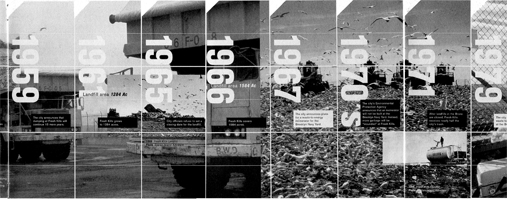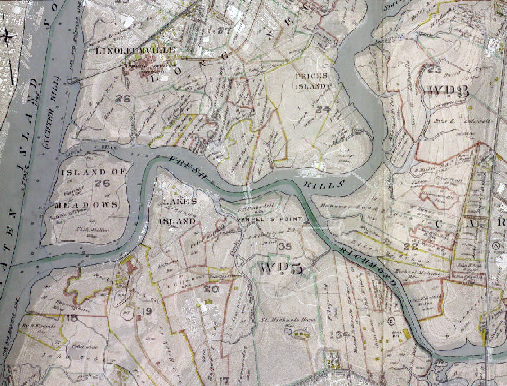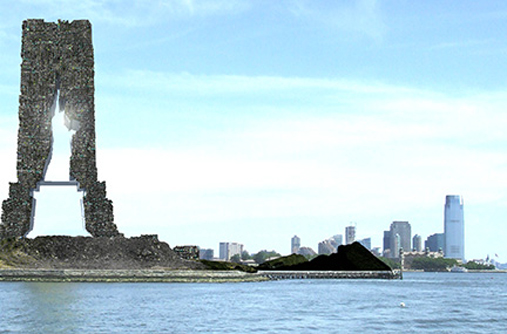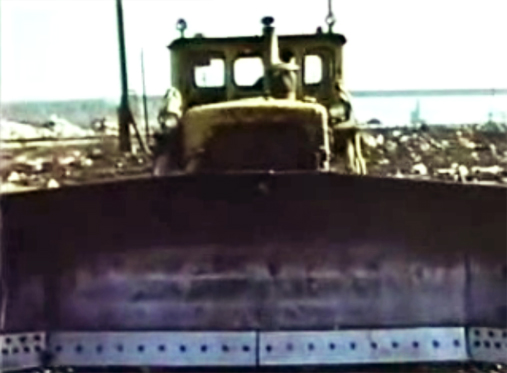A study in contrasts
More photos from our March photographers’ tour of the Freshkills Park site: Richard Levine has taken some beautiful shots not only this year (the first half of this slideshow), but also while the site was still open as a landfill, more than nine years ago (the second half).
Time gone by
Monday, March 22nd marked the nine year anniversary of the closure of Fresh Kills Landfill. To reflect on that milestone, we pulled this timeline (PDF, 11MB) of the landfill’s operation from our archives. It was put together for the catalogue of the exhibit called “Fresh Kills: Artists Respond to the Closure of the Staten Island Landfill,” mounted at the Snug Harbor Cultural Center‘s Newhouse Center for Contemporary Art in 2001.
The timeline doesn’t include every pertinent piece of information, of course. One important addition: in 1990, Governor Mario Cuomo signed a consent order placing the Fresh Kills Landfill under the governance of the New York State Department of Environmental Conservation (DEC); under that governance, the Department of Sanitation installed state-of-the-art infrastructure throughout the site to capture landfill gas emissions, collect and purify leachate and monitor the landfill’s impacts on surrounding air and water quality. These systems continue to operate today. More information on the site’s infrastructure and environmental controls is available under the ‘About the Site’ tab on the Freshkills Park home page.
New York City maps, rectified
The New York Public Library (NYPL) has unveiled a beta version of their map rectifier tool, a feature that allows users to digitally align or “rectify” historical maps from the NYPL collection with today’s maps and aerial photos. You can browse previously rectified maps or sign up for an account to align your own and add it to the browse-able archive. A 1907 map of the Fresh Kills area helped us understand a little more clearly the extent of filling in creeks and wetlands, and also the sense of private ownership that this land did, in fact, enjoy prior to the start of landfill operations–the entire site was carved up into privately owned parcels.
Fresh Kills, the sanitary landfill
An informative early-1980s video primer on the development of the contemporary sanitary landfill, with Fresh Kills as the prime example. Some interesting footage of the landfill in operation.
Important note regarding the narrator’s concerns about the quality of drinking water in the vicinity of landfills: Staten Island’s water supply, like that of the rest of New York City, comes from upstate New York and not from the immediate environment. There is also a naturally occurring clay liner at the bottom of the landfill mounds at Fresh Kills, which keeps leachate from seeping into the water table (in sanitary landfills without clay liners, synthetic liners are now installed). A vast infrastructure is in place within the mounds at the site to collect and process both leachate and landfill gas–you can read more about it under the ‘About the Site’ tab on the Freshkills Park home page.
City as garbage as City
A design proposal that seemed almost inevitable: New York-based architects Terreform propose the employment of automated robots in reusing garbage sited within the Fresh Kills Landfill to construct buildings and islands. The robots, refashioned from existing industrial equipment, would compact garbage into stackable units and be assembled like building blocks.
Wall-E, anyone? The firm’s proposal, Rapid Re(f)use, bears uncanny similarity to the animated robot’s activities, of course; their cleverness is really rendering the film’s scenario in real world architectural terms to reflect meaningfully on the relationship between the city and its waste. Terreform posits that the entire volume of the Fresh Kills Landfill, in addition to waste newly generated and collected, could be used to construct seven landmasses equivalent in size to Manhattan island. A provocative idea, for sure, and fodder for further academic discourse.
To be clear, though, we’re sticking to the park project.
(via Inhabitat)
Garbage Problems
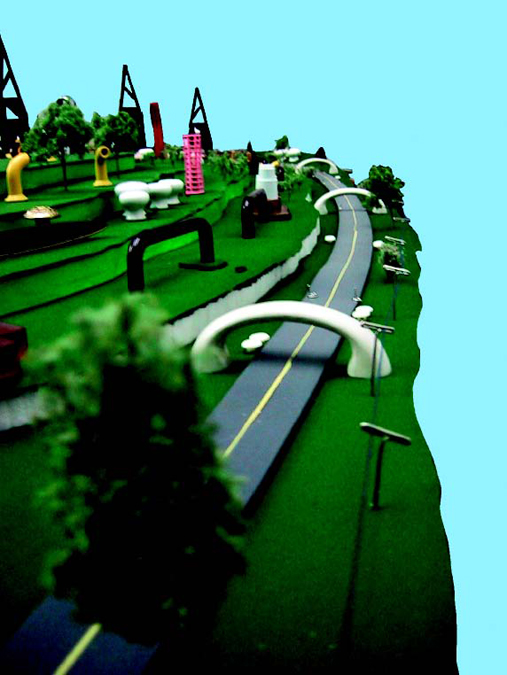
The model for a playful student design envisioning the future of Fresh Kills Landfill as a "Garbage City" complete with a waste-to-energy plant, farms, a super highway and "pinky man hotels" (above) where residents may live for free.
In 2002, a year after the Department of Sanitation and and the Municipal Arts Society announced the design competition for the reuse of the Fresh Kills landfill, the Center for Urban Pedagogy (CUP) embarked on an investigative project called Garbage Problems aimed at understanding the processes behind waste management in New York City. Working in collaboration with students from City-As-School high school, CUP produced a variety of compelling educational materials: a playful model and design plan for the reuse of the landfill called “Garbage City“; a 30 minute video on the project; and “The Making of Garbage Problems,” a large-format collage brochure explaining the project and providing a variety of resources on waste management in the wake of the closure of Fresh Kills.
Gordon Matta-Clark’s “Freshkill”
UbuWeb, the large online archive of avant-garde art, has posted a streaming video of Gordon Matta-Clark‘s 1972 “Freshkill,” filmed at the Fresh Kills Landfill. The short film depicts the destruction of the artist’s truck by a bulldozer. The video is also available for download as an MP4.
Ghost of sanitation infrastructure past
A quiet and handsome set of photographs by Nathan Kensinger showcases the decommissioned Hamilton Avenue Marine Transfer Station along Brooklyn’s Gowanus Canal. The station was closed along with the Fresh Kills Landfill in 2001 and is currently unoccupied. Its rehabilitation has recently been put out to bid to private waste management companies for use in barge export of waste, in accordance with the city’s 2006 Comprehensive Solid Waste Management Plan. All of New York City’s trash is now privately carted out of state–much of it via trucking. Barge export (and rail, which already happens in Staten Island and in North Brooklyn) would reduce the city’s sanitation costs significantly.
(via everydaytrash)
Steven Handel on urban restoration ecology
For our Freshkills Park Talk two weeks back, Dr. Steven Handel shared insights into the emerging field of urban restoration ecology, which focuses on the challenge of bringing ecological diversity back to degraded lands like brownfields and landfills. He discussed his research at the Freshkills Park site and others in the region and went on to describe how his expertise has informed the design of Orange County, CA’s Great Park.
Much of his discussion centered around concepts of ecological sustainability. Some key takeaways: At a site as large as Freshkills Park, it would be costly and unsustainable to plant and maintain the type of landscape found in a more traditional park landscape like Central Park. Dr. Handel emphasized the bang-for-buck of planting small, pioneer clusters of trees and shrubs that could attract bees and birds, which act as pollinators and seed spreaders. He also detailed the value of mosaic plant populations, in which some species can thrive while others shrink in response to evolving conditions. In the face of climate change, this adaptability, he said, would be essential for park resilience over time.
The talk covered much more. We’re grateful to Dr. Handel and to the big crowd that came out to hear him speak. Below are a few audio highlights. Each is 3 to 5 minutes long.
 Clip 1: The “ecological services” and other benefits provided by green, sustainable landscapes.
Clip 1: The “ecological services” and other benefits provided by green, sustainable landscapes.
 Clip 2: On Dr. Handel’s soil restoration work in the New Jersey Meadowlands.
Clip 2: On Dr. Handel’s soil restoration work in the New Jersey Meadowlands.
 Clip 3: The importance of pollinators and the challenge of aligning engineering goals with ecological goals.
Clip 3: The importance of pollinators and the challenge of aligning engineering goals with ecological goals.
How to Love a Landfill: June 20th at Freshkills Park
We get a lot of raised eyebrows when we first talk about the Freshkills Park Project with the uninitiated. Some folks are put off by the idea of landfills in general, and some are familiar with the stigma the site has given Staten Island over the past half century.
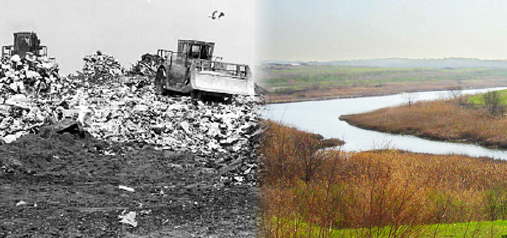
For skeptics and true believers alike, we’ve got a terrific event coming up Saturday, June 20th. Robin Nagle, the Department of Sanitation’s Anthropologist-in-Residence, will be giving a a talk and leading a conversation on top of the North Mound about why the Freshkills Park site deserves our love–and why she calls it ‘sacred space.’ She’s written an essay that digs into some of the themes she’ll be touching on as we sit out on top of the mound on chairs, blankets and yoga mats. You’re welcome to sign up for the event whether it sounds agreeable, provocative or flighty to you–at the least, you’ll get a free tour of the site out of it, and at the most, contribute to a healthy discussion. This is only our second event like this, but last month’s reading on top of North Mound was fantastic.
Robin is no lightweight: she teaches anthropology and urban studies at NYU and has been Sanitation’s official anthropologist-in-residence since 2006. Over the past several years, she’s been working to establish a New York City Sanitation Museum. She’s thought A LOT about garbage, the Department of Sanitation and Fresh Kills Landfill and has been featured in the New York Times and an episode of This American Life on garbage. We’re pretty excited about her talk.
Saturday, June 20th, 12pm-3pm
A Parks bus will pick up attendees at the St. George Ferry Terminal at 12pm, take them to the event, and deliver them back to the terminal at 2:30 or 3 pm. This event, like all of our events, is free, but space is limited. Contact Martha at martha.powers@parks.nyc.gov to reserve a spot.

